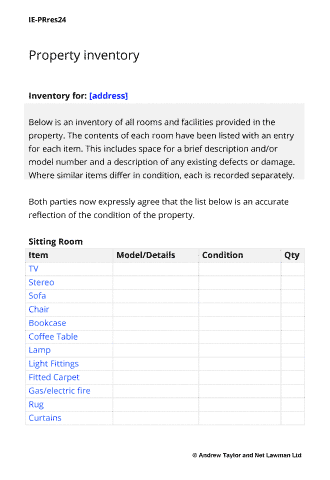Property inventory

Document overview


- Length:11 pages (513 words)
- Available in:
 Microsoft Word DOCX
Microsoft Word DOCX Apple Pages
Apple Pages RTF
RTF

If the document isn’t right for your circumstances for any reason, just tell us and we’ll refund you in full immediately.

We avoid legal terminology unless necessary. Plain English makes our documents easy to understand, easy to edit and more likely to be accepted.

You don’t need legal knowledge to use our documents. We explain what to edit and how in the guidance notes included at the end of the document.

Email us with questions about editing your document. Use our Lawyer Assist service if you’d like our legal team to check your document will do as you intend.

Our documents comply with the latest relevant law. Our lawyers regularly review how new law affects each document in our library.
About this document
The law provides for the swift return of a tenancy deposit to the tenant at the end of the tenancy. If there is a dispute, there are now set procedures for dealing with the dispute. To maximise your time and avoid litigation, all parties should agree the contents of the property thoroughly today. If all parties have signed the inventory and agreed how many pot plants there are, it will be clear at the end of the tenancy that if one is missing, the tenant isn’t due all of their money back. Of course the tenant might be due all of their tenancy deposit back, some or none. Once you have agreed the contents of your property, there is less room for dispute.
All Net Lawman residential tenancy documents include this comprehensive inventory. However, if you already have a lease or license agreement in place and have no inventory, it is a good idea to get one today and agree it with your tenant / landlord as priority. The law now requires that tenant’s deposits are more closely protected during the tenancy and that tenants are duly given back their deposit unless there has been adverse damage (other than reasonable wear and tear) to the property.
Application and features
- Suitable for use by a landlord or tenant
- Suitable for use with all types of tenancy agreement, leases and licenses
- Use as an addition to an existing tenancy agreement where there is currently no inventory
Contents
- Definition of 'Reasonable Wear and Tear'
- Comprehensive list of items that might be included in the property
- Examples of how to rate the condition of the items “(both fixtures and fittings)
- Space for estimation of cost to replace / repair the item in question
- Signatures showing agreement of all parties

Recent reviews
All rights reserved
